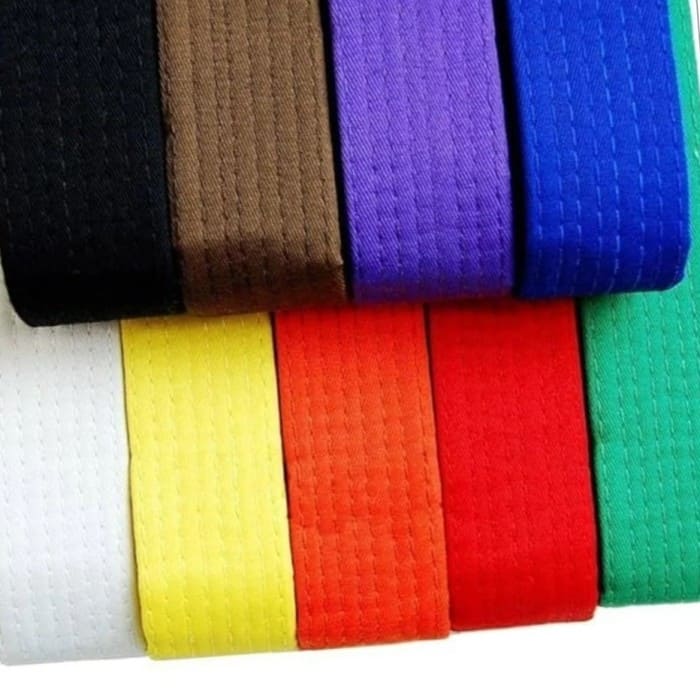Understanding Karate Belt Levels – A Simple Approach
It’s pretty clear that karate is far more than a fighting technique, it consists of discipline, respect, ethics, and bettering oneself. The most distinctive feature of karate among many is that it is taught in the form of a belt system in which a student earns belts as he or she advances in proficiency and skill level. This guide will explore the different levels of karate – the colors of the belts, karate belt levels and their respective ranks within the hierarchy, and self grading of karate students, together with the vocabulary pertinent to karate belts and their colors.
Karate belt levels | Karate belt order | Karate belt ranks | Karate belt list
The Order of Karate Belts | Karate Belt Grading | Karate Belts Stages
Karate Belt Levels | What are different belts in karate?
The ranks karate belt levels are grade and are best represented by colored belts, which give insight into the student level in the karate field, with the motion of the karate belts demonstrating the leaps made. Many karate styles share the following common belt order:
- White Belt: The first stage for every karate practitioner and a sign of getting started, this is a real blank slate.
- Yellow Belt: The young moves made by the previously still student.
- Orange Belt: Kouki the desire to work hard.
- Green Belt: An attempt to grasp the basic learned concepts.
- Blue Belt: The further attained goals are rarely defined.
- Purple Belt: A phase in between two stages which narrows the gap between strategies to different levels.
- Brown Belt: This represents a degree that is sufficient enough to be considered as preparing for a black belt.
- Black Belt: The last level accomplished in karate which is all about dominance and knowledge.

Types of Karate Belts | All Karate Belt Colors and their meanings
The karate system of colors is completely obliterated as every student is belted in one color which reflects the students’ capability and development within the institutions.
- White Belt: The white color indicates a clean slate, with no exposure and an untouched beginner level within karate.
- Yellow Belt: This color is associated with the rules of the practice in as much as the student is at the primary skill development stage.
- Orange Belt: This belt possesses a color that is easily identifiable and true to creating a greater sense of achievement and filling the gap of confidence.
- Green Belt: All learners start to think that they understand how hacking works, a frightening belt due to its wide degrees of freedom and progress.
- Blue Belt: After considerable training and the passing of time, this shade illustrates a greater capacity, full of hope and potential.
- Purple Belt: Comes after blue and demonstrates utilizing the tools in a focused manner, the shade itself as abandoned contains meaning.
- Brown Belt: The stage preceding black belt that almost has the same narrative to it, yet marks a longing for amputation.
- Black Belt: The tier after the brown belt indicates mastery over karate along with skill proficiency, years of hardship have led to this achievement.
Karate Belt Colors | How many belts are there in Karate?
There are nine primary belt colors primarily recognized and practiced in karate styles which include:
- White
- Yellow
- Orange
- Green
- Blue
- Purple
- Brown
- Red (in some forms)
- Black
There may be additional low belt ranks, various degrees or styles that differ in color and some of those might require the student to only master half of the color which explains why the majority of students are only aware of the above ranges.

Which is the ‘first belt in karate’ and ‘last belt in karate’ ?
The white belt, which represents a beginner’s willingness to learn, is the first belt in karate. On the other hand, the last belt in karate usually is the Black belt which on the other hand of the spectrum marks a significant skill and a deep understanding of karate art. There are several dan titles from first dan and upwards and these show different levels of expertise and experience and these can be assumed after a black belt.
Karate Belt Grading System
Considering that there are several schools and styles popularized all over the world, it is only wise to assume that they follow a similar structure but there is also another assumption that these systems are only dissimilar to an extent. The students are required by these specific systems to spar, master techniques and katas and even at times pass written examinations for them to progress from one belt to the other.
Time requirements for advancement
Usually there are set time periods before one should advance to higher levels or test for higher scores:
- White to Yellow: Approximately 3 months
- Yellow to Orange: About 6 months
- Orange to Green: Minimum of 6 months
- Green to Blue: Approximately 6 months
- Blue to Purple: Roughly 6 months
- Purple to Brown: Minimum of 6 months
- Brown to Black: After a great deal of training generally a number of years.
Karate Black Belt Levels | Karate belt levels within black belt
To earn Black belt in Karat is a remarkable point in a practitioner’s career, but even after this belt which has degree or “dan” which can be achieved:
- Shodan (1st Dan): The first degree black belt signifies basic proficiency at the black belt level.
- Nidan (2nd Dan): Represents advanced skill and understanding of karate principles.
- Sandan (3rd Dan): Indicates further mastery and often involves teaching others.
The maximum rank in some styles is 10th Dan and students may continue to earn higher degrees as they progress.

Image Credit: Pexels, Artem Podrez
Levels of Karate Belts in India | Karate belt levels in India
India follows a similar pattern as previously mentioned in regards to the karate belt system as do a lot of countries, only this time focusing on younger learners. Students generally start off with a white belt moving up the ranks until they reach a brown black belt. Some dojos or organizations may require specific mandates, but usually internationally recognized standards go for them.
Yes, there are notable differences in belt rankings between various karate styles, reflecting each style’s unique philosophy, training methods, and historical influences. Here’s an overview of how these differences manifest across popular karate styles.
Highest belt in karate | Which is the highest belt in karate?

Once you attain your black belt, you have only begun your journey, as the black belt comes with a new sense of responsibility. Black belts are further divided into dan based on the skills they possess, and awarded a parallel weapon for each skill division. Dan has a maximum of 10 ranks and the 10th rank is the highest achieved but also held by very few, as it requires you to not only be a technical expert but also a contributor to the art of martial arts, in other words, a founder. A more interesting fact is that between 9th dan and 10th dan, there are additional ranks which are regulated by governments of various countries.
Are there any differences in belt rankings between various karate styles?
Belt Ranking Systems in Different Karate Styles
For most Karate styles, a Kyu/Dan system is employed using colored belts for the novice, and a black belt for the experts, but apart from this generalization, there are significant differences between styles in the color and order of belts.

Image Credit: Pexels, Christoforos Christodoulou
1. Shotokan Karate
- Kyu Ranks:
- White (10th kyu)
- Yellow (9th kyu)
- Orange (8th kyu)
- Green (7th kyu)
- Blue (6th kyu)
- Purple (5th kyu)
- Brown (4th to 1st kyu with variations such as stripes)
- Dan Ranks:
- Black Belt (1st dan to 10th dan)
Shotokan is one of the most known systems and it has a starting from white to black belt distinction of level with brown belts including stripes for rank purposes level inside the belt.
2. Kyokushin Karate
- Kyu Ranks:
- White (10th kyu)
- Yellow (9th kyu)
- Blue (8th kyu)
- Green (7th kyu)
- Brown (6th to 1st kyu with variations)
- Dan Ranks:
- Black Belt starting from Shodan (1st dan) onward.
Kyokushin focuses on full contact sparing and follows nearly the same structure for the belts but other colors or more requirements to be promoted to the next level are present.
3. Wado-Ryu Karate
- Kyu Ranks:
- White
- Yellow
- Orange
- Green
- Blue
- Brown
- Dan Ranks:
- Black Belt, with degrees similar to other styles.
Wado Ryu also has some influence from jujitsu, which could impact its training methods and belt requirements, although the general hierarchical system is in line with the kyu/dan criteria and structure for ranking levels.
4. Goju-Ryu Karate
- Kyu Ranks:
- White
- Yellow
- Green
- Blue
- Brown
- Dan Ranks:
- Black Belt with multiple degrees.
Goju Ryu has both hard and soft techniques as well, and though the Goju belt colors are consistent with other systems there may be differences in rank advancement level requirements because of how kata and emphasis on breathing techniques were taught and incorporated.
5. Shito-Ryu Karate
- Kyu Ranks:
- White
- Yellow
- Orange
- Green
- Blue
- Brown
- Dan Ranks:
- Black Belt with degrees.
Shito-Ryu incorporates a wide variety of kata from different styles, which may affect the specific requirements for rank advancement compared to other systems.
Variations in Belt Colors and Requirements
While many karate styles share similar belt colors, some have unique variations or additional ranks:
- Stripe Belts: Some dojos use stripe belts within each color rank to signify further progress before moving up to the next solid color belt. For example, a brown belt might have one or two stripes indicating different levels of proficiency within that rank.
- Provisional Black Belts: Certain styles may award provisional black belts (shodan-ho), indicating that a student has achieved the black belt but must continue demonstrating their skills over time before being fully recognized as a black belt.
In summary, while there are overarching similarities in the karate belt ranking systems across various styles, significant differences exist in terms of color order, specific requirements for advancement, and additional ranks or titles. Understanding these distinctions is essential for practitioners as they navigate their training in different karate disciplines. Each style’s unique approach to ranking reflects its philosophy and training methods, contributing to the rich diversity within martial arts.
Purpose of belt stripes within the karate belt system
Belt stripes are a feature of the karate belt system which make it easy to understand the advancements of a student within a given rank. These stripes are usually placed on a colored belt, yellow, green or brown for instance, to represent certain levels or skills acquired by the student before the change of the next belt color. This system allows for finer gradations to be made in the level of the student and also assists them not to lose focus as they aim for higher rank. Each stripe is usually associated with some skill(s) or technique(s) which the student has to regularly perform in order to get it.
Stripes are in usage in some of the martial art institutions while in others they are not; within the shirinjiryu, some kyu and dan grades use them while other kyu and dan grades do not. For example, in some systems every student who holds the same belt has been allocated a fixed number of stripes while in other systems, students progress on an individual basis; in some systems, students might have to earn one or two stripes, before testing for green, orange and finally the red blue belt.
This is not only in aspects of skill mastery but also forms (katas), sparring, self-defense techniques and so on. This logically organised system not only caters for divisions of intra martial art competitions but cultivates for appreciation of short term goals and therefore better self-regulation of the students jointly within the martial art.
Conclusion
Belts displayed on the karate practitioners showcase the advancement made during the course of training. With each different color belt, a practitioner is able to advance in rank and skill level. All belts starting from white to black represent achievement and persistence. Practitioners who wear a black belt are considered at the top of their craft and hold immense skill.
Practitioners do not just acquire skills but rather positive traits such as determination, honor, and modesty as they advance these traits are the true characteristics of a martial artist. As they proceed through the different ranks, they also acquire more honor and respect which is the true mark of a karate practitioner.
As we have seen, practicing karate whether for the first time or for a long time can be interesting by knowing about the different belts that one can earn and wear as one seeks to understand the various skills integral to the art form.
Must Read,
✔️ Varma Kalai: Treatments, Classification, Techniques
✔️ How to Scrap Old Bike Legally in India: Step-by-Step process
Frequently Asked Questions (FAQs)
Are there any karate styles that use a different ranking system altogether?
Of course, there are karate styles that employ different ranking systems completely. While many adhere to the kyu/dan grading system, some may use orthodox approaches or modifications. For instance:
Goju-Ryu: It normally takes the kyu/dan hierarchy but might have some specifications and kata routines that are not the same as those of other styles.
Shorin-Ryu: Kata forms as well as manoever technique of this style could be in less belt colours and practical usage with simpler ranking may take precedence.
Kuk Sool Won: It is majorly Korean martial art although it has some techniques of karate and practices its own methods of grading.
In addition, other martial arts include Muay Thai, kickboxing and mixed martial arts (MMA) have no belt ranking system at all and concentrate on mastery of skills and much competition experience without ranks.
Which martial arts use a ranking system other than belts?
Several martial arts practice grade hierarchies other than the traditional belt system. Some of such cases are:
Boxing: Boxing has no recognized grade structure, performance level is judged by sparring and competition achievements.
Wrestling: Rank’s component in wrestling is analogous to that in boxing in the sense that results of competitions are used and a belt system is absent.
Muay Thai: Traditionally, there is no belts in Muay Thai, although some western branches use armbands or some other recognition.
Mixed martial arts (MMA): MMA has different fighting styles embedded in it and some of the styles do not have a belt ranking system, the competition level is used instead.
Kickboxing: In general kickboxing practitioners do not adopt the use of belts as most in Muay Thai, progression in rank is based on level of skill not formal ranks.
Krav maga: This self defense system has its own levels of ranking, however; specific ranks colors similar to those in other martial arts are not used.
These martial arts emphasize competition and practical usage which do not require a formalized ranking system such as belts.
What are the main differences in the belt colors used in karate and judo?
Judo and karate make use of different colored belts, both in terms of their basic construction as well as what each belt signifies. Usually, for example, a karate practitioner would start with a white belt and after that move up the ranks which are denoted by colored belts – in this case it is yellow, orange, green, blue, purple, brown and then final black – although it is not uncommon to see the addition of stripes or even another lower two-colored belt to indicate progress made in between two higher levels.
These colors are significant with each color designated to a certain phase of mastering techniques. On the other hand, judo tends to have a more straightforward color system for belts whereby practitioners utilize a white belt first and once the kyu grade is achieved there are colored yellow, orange green, blue and brown belts, with the dan level belts being black.
There are some other kinds of judo belts that are consistent with the 6th to 8th dan belts that are striped red and white, and the highest dan ranks that are solid red, which together do modify the whole judo belt color scheme structure contrary to karate.






